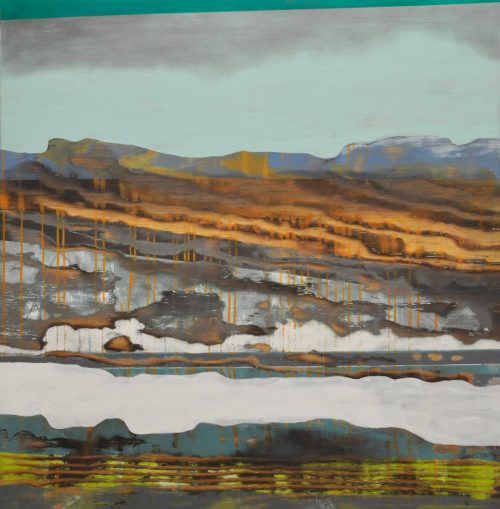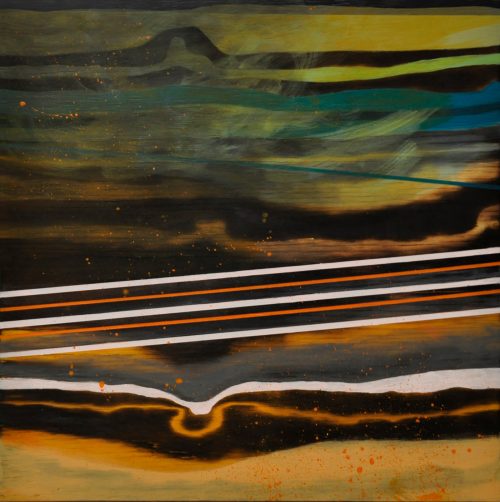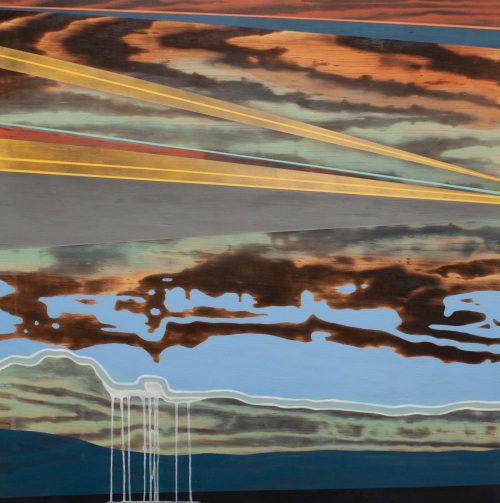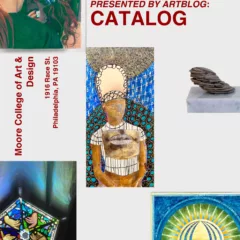
Pictures of the floating world — ukiyo-e
Michele Kishita paints abstract, impressionist landscapes on sugi ban panels of burnt timber. Shou Sugi Ban 焼杉板 (or Yakisugi) is a centuries-old Japanese technique for preserving and finishing wood by charring it with fire.
Her intention, as I understand it, is to conjure up the lost natural landscapes from which the wood she is painting upon originates. Her paintings seek to reflect the histories of those landscapes, which are embedded in the wood of trees, and to include various human-made interactions upon those environments, such as human-caused deforestation. The work thus explores landscapes which no longer exist, and suggests forms of their transformation, and perhaps their resurrection.
Kishita’s exhibit, Absent Futures, at the Central Tattoo Studio and Gallery, includes eight of these paintings. Each of them is dreamy, vast, and uses the undulations of the burnt wood panels to depict bold, rich landscapes and skyscapes. Moreover, they each incorporate an abstract form of human-made movement, or line. Yet these potentially disparate elements flow together and are connected with surprising harmony in most of the paintings — exemplified here in “Another Dawn” and “When There Was Ice” — abetted by the artist’s absolutely unique use of color. In both of these paintings, for instance, earth tones are offset against tinges of green, orange, or even copper, which glow and seem almost unnatural.

By contrast, in the third image included here, “After the Fact,” what appear to be human-made lines evoke the potential for clash when humanity imposes itself upon the natural environment.
Kishita thus reminds us how easy it is to get it wrong, to lose sight of the ways in which we can respect and harmonize with the natural environments that we intrude upon.
Art and the exposition of climate change
For some time now, I have been interested in how climate change has wormed its way into the work of contemporary artists.
One of the problems this highly politicized, scientific issue presents is that it is difficult to explain to people. For too many of us, climate change remains an abstraction, and for far too many of us, it is conceptualized as a matter of belief.
What I often discover is art work, oftentimes brilliant art work, that attempts to portray the manifestations of climate change in the natural world. Receding glaciers, for example, or sea level rise, are often depicted or evoked. However, regardless of the artistic merit or ingenuity of the work, it usually requires exposition. And Michele Kishita’s work is no exception.
I’ve reluctantly come to the conclusion that the most effective way to use art work as a vehicle of communication about climate change is to abandon all subtlety. One excellent example of this is Hannah Rothstein’s work, in which she recreates iconic American national park posters, starkly depicting how the parks will appear in 2050 if we fail to act against climate change.
Michele Kishita is a Philadelphia based artist. She received her MFA in Painting at the University of the Arts in 2010. Her Absent Futures will be on display at the Central Tattoo Studio through March 29th 2020.










